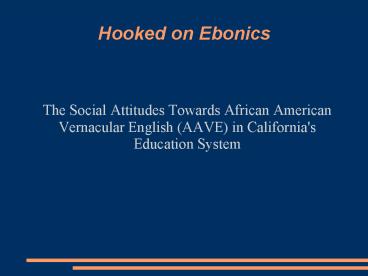Hooked on Ebonics - PowerPoint PPT Presentation
1 / 14
Title: Hooked on Ebonics
1
Hooked on Ebonics
- The Social Attitudes Towards African American
Vernacular English (AAVE) in California's
Education System
2
Origins of AAVE
- Different views of origin
- Incorrectly learned English
- Dialect containing many W. African elements of
grammar - 1700s to 1900s almost 90 of blacks lived in the
South - Blacks in the North lived in segregated
communities and had ties to the South
3
Dialect vs. Language
- Dialect is
- Language is
- AAVE is categorized as both, according to who is
authoring the decision
4
1996 Oakland District Decision
- Classified AAVE as a language most spoken by
black students in their school district - Different interpretations of ruling
- Ebonics to be taught in classroom?
- Supreme Court Decision of 1979
- Stigma
- Teacher population's perception as
incomprehensible - White, monolinguals
5
Attitudes towards AAVE
- STIGMA
- Said this accounted reasons for high unemployment
rates in blacks - Black children under-perform in standardized
tests - AAVE equated with ignorance and other negative
connotations - Categorized as bad rather than as different
6
Supreme Court Ruling 1979
- Ann Arbor, Michigan
- Black students were put into special education
courses unnecessarily - Result
- Teachers must take into account the personal
language patterns of their students. - Students have the civil right to be taught in a
language which they can comprehend
7
Oakland Student Performance
- Schools failed to educate AA students
- Stigmatization of AAVE
- Turned their speech into a disadvantage
- Teachers perceived students as less smart
- What other dialect is equally stigmatized?
8
Supreme Court Decision 1979 Results
- Bilingual programs in the 1980s and 1990s
- Requires teacher to learn features of a language
and how students acquire a language - Make connections with what student already knows
- Very similar to how AAVE is used in Cali.
Classrooms - Use of nonstandard to teach the standard
- Mastery of language is impeded when learner is
devalued - Identity
- Psycho-educational principle
9
Federal Bilingual Education Act
- For the teacher, this means that differences in
language usage among African-American students
should not be ascribed to greater carelessness,
laziness or stupidity on the part of Negroes, but
rather should be treated as what they really are
-- language patterns which have been in existence
for generations and which their present users
have acquired, from parent and peer, through a
perfectly normal kind of language-learning
process. (rationale point 3)
10
Statement from the National Council of Teachers
of English
- We believe that The Black language system of
itself is not a barrier to learning. The barrier
is - negative attitudes toward the language
system - lack of information about the system
- inefficient techniques for teaching
language skills - and an unwillingness to adapt teaching
styles to student learning needs - Written before Cross-cultural, Language, and
Academic Development (CLAD) credential
11
Educators of the Los Angeles Unified School
District
- THERE IS A NEED TO
- Recognize and value African American
language (Black Language) as a viable
language with its own system of rules,
sounds, and meaning. - Help students learn to switch from African
American language to standard English, when
appropriate. - Use teaching strategies that capitalize on
identified student strengths.
12
Basis
- Language is an integral part of one's
identity and culture - The dignity of a person is not guaranteed
unless the dignity, of his or her people is
preserved - The unique history, culture, and language
of each child must be recognized and respected - Teaching methodology must accommodate the
culture and language of the child
13
Ebonics in Classroom
- Use of Vernacular to teach the Standard
- Retain home dialect, not replace it (identity)
- Non-traditional teaching methods
- Word drills, translate from standard English into
AAVE and vice versa - QA drills to understand context
14
Citations
- Williams, P.J. (2001). The hidden meanings of
black English. The black scholar,27(1). - Croghan, M.(2000). History, linguistic theory,
California's CLAD, and the Oakland public
school resolution on ebonics what are the
connections? World englishes,19(1). - Perez, S.A. (2000). Using ebonics or black
English as a bridge to teaching standard
English. Contemporary Education, 71(4).





![READ⚡[PDF]✔ Hooked: A Dark, Contemporary Romance (Never After Series) PowerPoint PPT Presentation](https://s3.amazonaws.com/images.powershow.com/10049520.th0.jpg?_=20240607026)

























